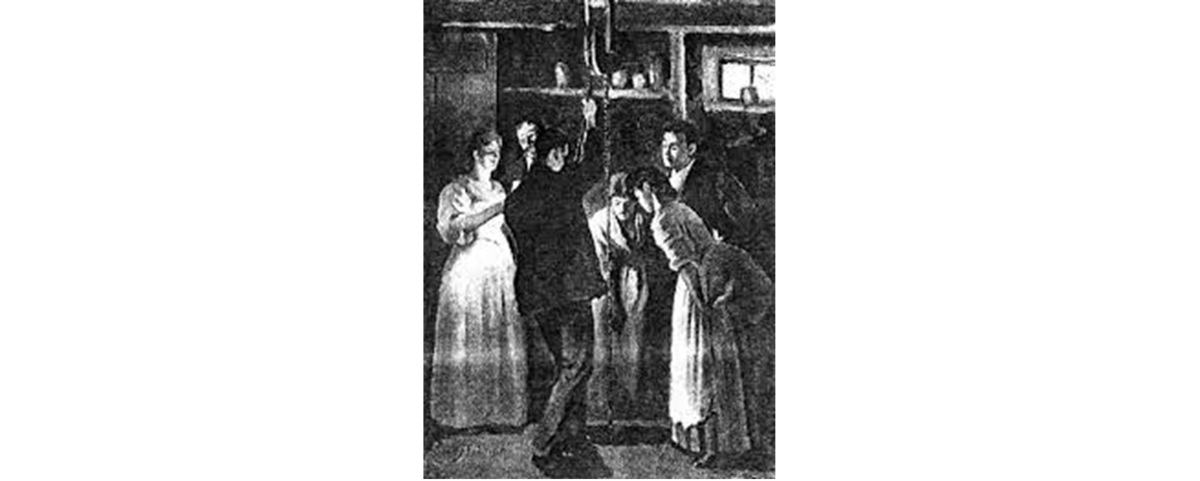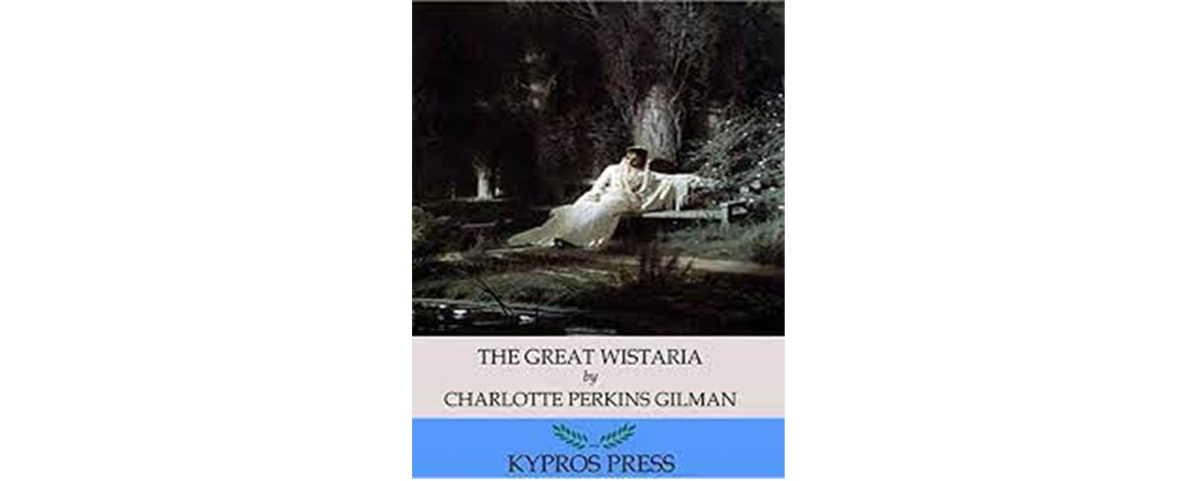The Giant Wistaria Walked so that The Yellow Wallpaper Could Save Lives

For a long while, I considered Charlotte Perkins Gilman’s The Giant Wistaria a serious betrayal. Far inferior to her 1890s classic, The Yellow Wallpaper, and sharing much more in common with it than just a vaguely similar title format, The Giant Wistaria seemed to represent to me an unprecedented reversion of an author’s competency, sophistication and nuance.
When I first read The Giant Wistaria, there was no justifying its gross overuse of adverbs, the haphazard attempts at old English, the chronically underdeveloped story and the tonal yo-yoing of “comedy” interspersed with poorly executed horror, especially in the shadow of Gilman’s previous triumph – The Yellow Wallpaper, a short story so powerful that it is credited with saving at least one woman from serious mental illness and with changing the minds of the male-dominated field of 19th century medicine.
Except, there is. See below:
The Giant Wistaria (1891)
The Yellow Wallpaper (1892)
So misguided was this first reading of mine and so enraged past the point of obvious reasoning (of course, authors don’t just suddenly regress – they improve!) that I fled to my laptop in a rage and dashed out a malicious piece of analysis titled The Giant Wisteria [sic] by Charlotte Perkins Gilman is a giant, wasted shame.
Oh, retrospect, how you haunt me.
And it is precisely in retrospect that I have reached my conclusion: The Giant Wistaria walked – or limped pathetically – so that The Yellow Wallpaper could run. You could argue this “trial run” of themes of female sexual repression and the regular patriarchal intrusions into 19th century motherhood had laid important groundwork within Gilman’s writing portfolio so that when the time came to produce something truly heartfelt and meaningful, when it mattered, this amazing early feminist author was fully prepared.
Of course, I have no proof that Gilman directly referenced The Giant Wistaria when she wrote her much acclaimed short story, or that she even had a subconscious pathway linking these texts in anyway, but if you’ll indulge me, I will explain just how The Yellow Wallpaper improves on its predecessor and plot just how far Gilman’s writing came in just one year.
Either Gilman has such an uncanny love for disused haunted houses and old gardens in disrepair that she just can’t help writing about them or it should strike every reader as strange that both The Giant Wistaria and The Yellow Wallpaper are set in such places. However, I don’t have to tell you that The Yellow Wallpaper did it better.

The Giant Wistaria begins with a short scene of two parents desperate to cover up their daughter’s illegitimate child, born out of wedlock, by fleeing their home and leaving the child behind. The scene then changes over to a couple, Jenny and George, who want to rent the old house because they’re “sure it’s haunted” (which is very compelling), leading them to invite 4 more characters along to explore the house’s troubled past and solve the mystery of the wondering ghost girl. Similarly, The Yellow Wallpaper begins with a couple moving into a seemingly haunted holiday home, but it is heavily implied that the narrator and her husband have come here to help “cure” the narrator’s postnatal depression and keep her away from work. As she undergoes this isolating form of treatment, this new mother experiences a gradual spiral into insanity.
Already, we can see just how integrated into the story’s message and plot the house is in The Yellow Wallpaper compared to the tenuousness of The Giant Wistaria’s excuses. Where one house is entered on a whim, the other is given a purpose. Where one house has no connection to its characters besides a thinly explained desire to go ghost hunting, the other becomes the mysterious and incomprehensible metaphor for the narrator’s mental state.
Notably, there isn’t a great deal of point to The Giant Wistaria’s characters. None of the characters actually have a connection to the woman in the first scene who had a child out of wedlock and must now marry a cousin she repeatedly rejected. None of them, we are told, have experienced anything similar. No, instead they exist to experience the main “horror” of the story after it happened decades – or even centuries – ago, each of them looking on a wronged woman’s remains in shock and bewilderment. We never find out what truly happened to her child. All we know is that it spent the best part of a century in the bottom of a well for some unspecified, allegedly misogynistic reason. And there is so much distance between the feminist messaging, the assumed advocation for women’s sexual freedom and control over their reproductive rights, and the reader who is meant to learn from this messaging that all you can do is feel confused.

But in The Yellow Wallpaper, Gilman does away with her ‘bad thing happens to a woman off screen’ method of storytelling. Instead her accomplished short story brings women’s rights and patirachal malpractice into the forefront through a woman’s real experience – real in the sense that Charlotte Perkins Gilman was actually prescribed this treatment herself, including being shut away and commanded to stay away from work, and although the story’s events are much exaggerated, Gilman suffered the same form isolation. It is reasonable to assume that much of the story drawn on her own experience for inspiration. Perhaps we could credit a lot of the realism, believability and even sophistication of this text to Gilman’s passion for this topic in her own life, or even just to the fact that she wrote about what she knew.
While The Giant Wistaria’s successor utilised the ghostly happenings within its setting to the maximum, using the moving, yellowing wallpaper to personify the character’s mental decay and the claustrophobic top-floor nursery to escalate a sense of unease, social isolation and psychotic trickery, The Giant Wistaria has a much dottier relationship with its haunted house. First of all, its “yellow wallpaper” takes the form of the purple, draping wistaria around the front of the house. This instantly creates several problems; wistarias happen to be plants and plants are generally quite calming and peaceful things, so in the horror setting (plus the “comedy” we’ll touch on later) this motif is completely tonally dissonant. Now it’s debatable whether Gilman was aware of the wistaria vine’s exact connotations, but connotations of love, sensuality, support, tenderness, bliss, long life or immortality and of “expanding consciousness”, which I take to mean becoming more empathetic and connected in a community, actually work to contradict the parent’s insensitive treatment of a new mother in the first scene. If the woman’s mother loved her wistaria vine so much, essentially making the vine a pseudo bible for her character’s sense of morality and social justice, then why act so callous towards her daughter? Unless these connotations were deliberately used ironically, as if the wistaria is this unwed mother’s only comfort, there is not a lot in The Giant Wistaria’s 3000 words to justify this soft, comforting imagery.
There is also the problem of the ghost girl. The Yellow Wallpaper has a creeping woman (and then many creeping women) that starts at first as a trapped entity behind the wallpaper, which scares the narrator. But gradually, the narrator starts to empathise with this woman in the wallpaper, to embrace her, to help her – until the reader is forced to confront the fact that the woman in the wall was the narrator all along, frustrated, trapped and perhaps considering herself a “monster” for failing to fulfil her societal role of a mother and wife due to mental illness. The ghost girl in The Giant Wistaria is kind of just there. She goes through some people’s rooms at night, rummages in some draws, reveals a vague history of the house and her own past – allegedly a mother attempting to run away or elope – but other than that her relation to the George, Jenny and co is non-existent.
Which speaks to the previously mentioned and much larger issue; the irrelevancy of The Giant Wistaria’s characters. When you’re not struggling to work out who’s speaking, and when you’re not searching for clearer identifiers for each character besides “X’s pretty sister”, you’re wondering why any of them are even here. None of them have similarities to the primary facts we know of the ghost girl. None of them are parents out of wedlock, none of them seem to be parents at all or planning to be, none of the women even seem bothered by their husband’s patriarchal control over their wombs or whatever else the message was meant to be. They are blatant vessels for us to experience the story through, a set of 6 excuses to explore a random house with a random message.
Due to this irrelevancy problem, The Giant Wistaria’s message fails to resonate with us, especially as we experience the struggles of the mother from an ever greater distance: first, through an observational third person, then through a huge gap in time, and lastly through the indistinct, unrelated eyes of 6 characters with no reason to dig up the poor woman’s trauma or disturb her grave. The message just becomes so diluted, no wonder the wistaria imagery just can’t take hold.

The framing of The Yellow Wallpaper, on the other hand, elevates Gilman’s story until it becomes her masterpiece. Not only do we solve the distance problem with present time, first person and bringing the narrator into the spotlight of the tale, Gilman achieves a truly immersive story by writing the text as a diary. And not just any diary, a diary the narrator is not allowed to write. The very existence of the text is a feminist rebellion against male control. When she is forbidden to “work”, too fragile as a woman – as a sick woman – to be doing any kind of work at all, according to her husband, she shows the irony of men claiming to know more about women’s bodies and psychology than women themselves and provides a damning receipt of male incompetence and negligence in 19th century medical spheres.
When the narrator of The Yellow Wallpaper had no voice in a male dominated environment, she found a way to be vocal and honest through her writing. And I almost see it as a call to action for other women to pick up their pens and show the world just what they think and just what it’s like to be a woman – because women are the only ones who can.
The Giant Wistaria is riddled with a lot of “not quites”: the “not quite” characters, the “not quite” extended metaphor of the wistaria, the “not quite” old English dialogue, the “not quite” comedy and “not quite” horror – and as you can imagine this really detracts from the text’s literary pedigree. It seems though, Gilman got the hang of things, or realised they were better left in the drafts, just 1 year later. And a great place to look for this authorial development is in her dialogue.
You could say the dialogue in The Yellow Wallpaper is much better than The Giant Wistaria by virtue of their being a lot less of it. While this is true, even with limited dialogue, The Yellow Wallpaper avoids its predecessors short comings. Where The Giant Wistaria is seeming one endless conversation, I’d argue the realistic, humanised dialogue of The Yellow Wallpaper finds its routes in Gilman giving every one of her characters a purpose (and having less characters in general).
John, the husband, is a doctor and not inclined to believe his wife or consider her a reliable human being, and he behaves exactly in this way. Each piece of dialogue has medical origins or a hint of buttery sweet 19th century misogyny. And it works! Especially when compared to The Giant Wistaria’s Geoge, also a husband and supposedly a lawyer, who teases his wife about the wistaria, cracks bad jokes and speaks like he’s never made small talk before. His purpose in the story? To bravely walk into the cellar after a ghost and make unconvincing but meant to be convincing comments about not believing in ghosts in the first place. At least he’s the only one like this, right?
Nope. We have Jim and Jack, named in a very non-confusing way, who both maintain they don’t believe in ghosts, except to varying degrees. Which is, again, very compelling.
Also, see this interaction – its truly masterful:
“[…] Its my opinion you’d better let well enough alone!” quoth Jim.
“Truth lies hid in a well, and we must get her out,” said George. “Bear a hand with the chain?”
Jim pulled away on the chain […]
Firstly, are these character’s even talking to each other? Secondly, why was Jim so easy to convince? Is George Jim’s 19th century husband as well? And thirdly, “quoth”?
And don’t get me started on the jarring personification of “truth” as some kind of woman. I get it women = honesty and knowledge and intuition about ghosts apparently, but why is George speaking like that?
Well, its not as bad as “But the young householder suspecteth burglars, even as a medical man he knoweth nerves” says George, the lawyer (??), or “It groweth well, this vine thou broughtest me in the ship, my husband.”
Look, I’m no historical researcher or writer, but I’m pretty sureth adding “eth” and “est” to the ends of words do notest make them Old English. And if George is such a medical man, or a lawyer supposedly, it feels quite inconsistent for him to break into simile and personification like this, making porch planks into “trap doors” to China and “truths” into women.
The Yellow Wallpaper avoids these problems by having characters speak natively and normally. They speak within the realm of their experience: 19th Century America, medicine, and domestic life. Easy. Things generally get difficult in writing when you stretch beyond what you know and don’t support your writing with thorough research to fill in those knowledge gaps. Perhaps post The Giant Wistaria, Charlotte Perkins Gilman became aware of this.
A few problems in the honourable mentions are the stereotypical nature of the 6 characters in The Giant Wistaria. This issue works to make each character quite shallow, boring and blurred together. The use of adverbs in unnecessary places (“where carpenters of miraculous promptness were tearing things to pieces generally”) and the not funny jokes throughout the text are also worthy of note. In contrast to the stereotyping in The Giant Wistaria, the stereotypical nature of John and his sister serve to be ironic criticisms of their society in The Yellow Wallpaper, of the flaws of such thinking people, and when it comes un-funniness and a seeming adverb apocalypse throughout The Giant Wistaria, The Yellow Wallpaper omits both issues from every line.
In fact, when the narrator does try to be funny or witty it is excusable by the fact that they are her private thoughts, in-jokes with herself, or for those moments that are particularly jarring, it’s easy to mark them down as the ramblings of an increasingly mentally unstable woman. Overall, the jovial writing tone that Charlotte Perkins Gilman has in most of her texts actually serves as a great contrast to the disturbing horror of The Yellow Wallpaper, most likely shaping the tale into something more palatable for a more censured time, while the strange humour and writing tone of The Giant Wistaria makes the hauntings in its story harder to take seriously.
On the whole, I think Charlotte Perkins Gilman showed either an incredible insight into the previous flaws of her writing by putting those hard lessons into practice with her rightfully beloved story, The Yellow Wallpaper, or what god there is out there decided to help her out this once just for the sake of all those who she would go on to influence and save. I have not yet read enough of Gilman’s work to hazard a strong guess. But whatever the case, I still enjoy entertaining the idea that The Giant Wistaria was just one turd-like steppingstone towards a much greater writing career. Hell, maybe The Yellow Wallpaper could even be the second – no tenth draft of its extremely flawed predecessor, giving us all hope that something beautiful and meaningful can be polished out of even our worst stories.
02/02/2022
To be proofread...